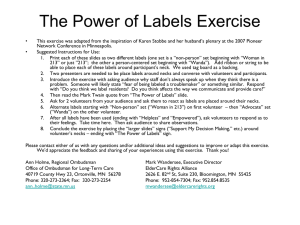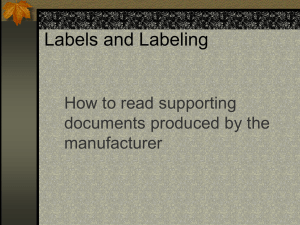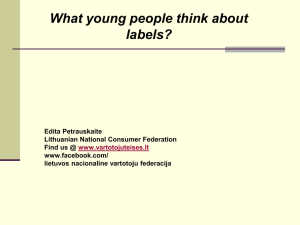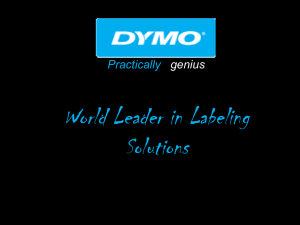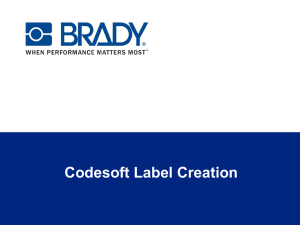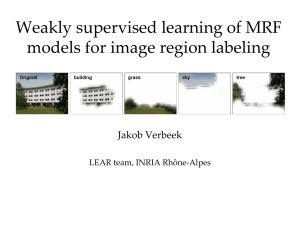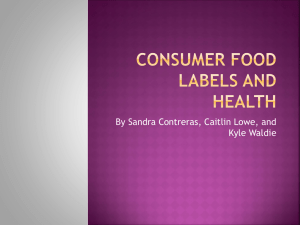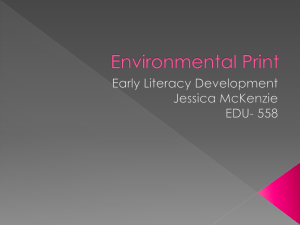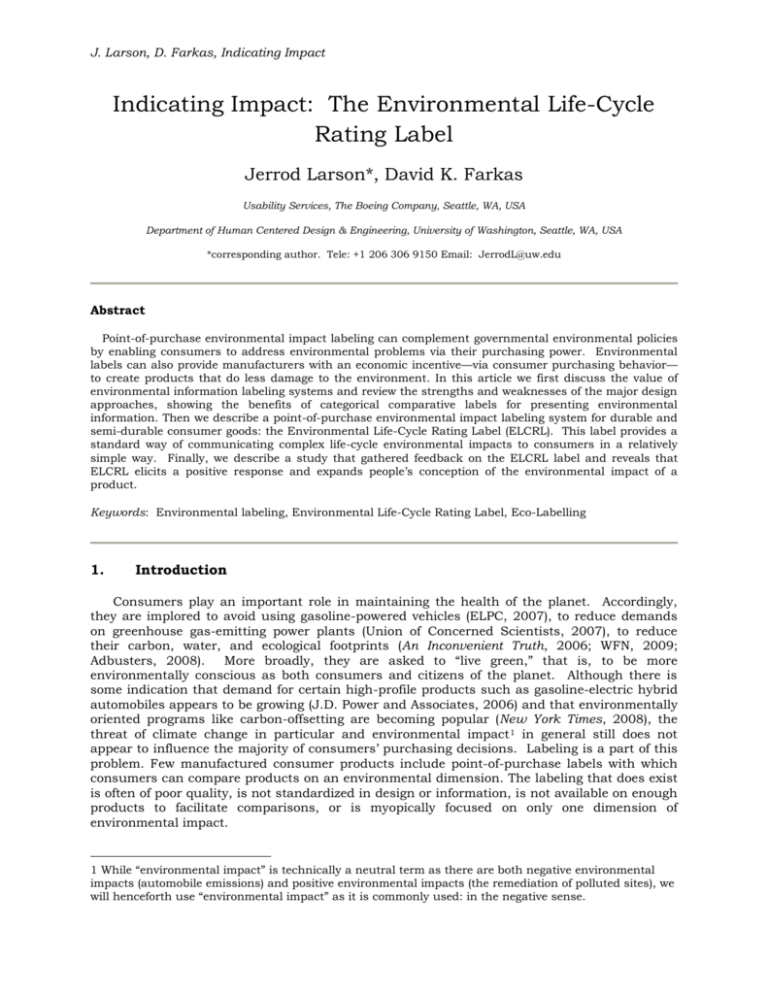
J. Larson, D. Farkas, Indicating Impact
Indicating Impact: The Environmental Life-Cycle
Rating Label
Jerrod Larson*, David K. Farkas
Usability Services, The Boeing Company, Seattle, WA, USA
Department of Human Centered Design & Engineering, University of Washington, Seattle, WA, USA
*corresponding author. Tele: +1 206 306 9150 Email: JerrodL@uw.edu
Abstract
Point-of-purchase environmental impact labeling can complement governmental environmental policies
by enabling consumers to address environmental problems via their purchasing power. Environmental
labels can also provide manufacturers with an economic incentive—via consumer purchasing behavior—
to create products that do less damage to the environment. In this article we first discuss the value of
environmental information labeling systems and review the strengths and weaknesses of the major design
approaches, showing the benefits of categorical comparative labels for presenting environmental
information. Then we describe a point-of-purchase environmental impact labeling system for durable and
semi-durable consumer goods: the Environmental Life-Cycle Rating Label (ELCRL). This label provides a
standard way of communicating complex life-cycle environmental impacts to consumers in a relatively
simple way. Finally, we describe a study that gathered feedback on the ELCRL label and reveals that
ELCRL elicits a positive response and expands people’s conception of the environmental impact of a
product.
Keywords: Environmental labeling, Environmental Life-Cycle Rating Label, Eco-Labelling
1.
Introduction
Consumers play an important role in maintaining the health of the planet. Accordingly,
they are implored to avoid using gasoline-powered vehicles (ELPC, 2007), to reduce demands
on greenhouse gas-emitting power plants (Union of Concerned Scientists, 2007), to reduce
their carbon, water, and ecological footprints (An Inconvenient Truth, 2006; WFN, 2009;
Adbusters, 2008).
More broadly, they are asked to “live green,” that is, to be more
environmentally conscious as both consumers and citizens of the planet. Although there is
some indication that demand for certain high-profile products such as gasoline-electric hybrid
automobiles appears to be growing (J.D. Power and Associates, 2006) and that environmentally
oriented programs like carbon-offsetting are becoming popular (New York Times, 2008), the
threat of climate change in particular and environmental impact 1 in general still does not
appear to influence the majority of consumers’ purchasing decisions. Labeling is a part of this
problem. Few manufactured consumer products include point-of-purchase labels with which
consumers can compare products on an environmental dimension. The labeling that does exist
is often of poor quality, is not standardized in design or information, is not available on enough
products to facilitate comparisons, or is myopically focused on only one dimension of
environmental impact.
1 While “environmental impact” is technically a neutral term as there are both negative environmental
impacts (automobile emissions) and positive environmental impacts (the remediation of polluted sites), we
will henceforth use “environmental impact” as it is commonly used: in the negative sense.
J. Larson, D. Farkas, Indicating Impact
Take, for example, the U.S. EPA’s automobile and light truck labeling program (EPA, 2007).
This program requires manufacturers to disclose vehicle fuel economy, an important factor in
vehicular environmental impact (Gleick, 2007). Unfortunately, however, these labels do not
disclose a vehicle’s greenhouse gas emissions, nor do they tell the consumer anything about
the environmental costs to produce or to recycle particular vehicles. Without such information
consumers cannot make a complete, informed decision regarding what vehicles are better for
the environment than others. And as we know, the energy efficiency of a vehicle in use is only
one factor comprising the total environmental impact of a vehicle. Other factors include the
impact of harvesting and creating raw materials, the impacts that arise from manufacturing,
the emissions resulting from use, recycling and disposal costs, and so on.
Of course this problem goes well beyond vehicles. Is a computer monitor with relatively low
energy consumption a better overall environmental choice than an inefficient monitor whose
manufacturing process does far less damage to the environment and whose components are
easy to recycle? Ultimately the question Is product A a more environmentally responsible choice
than product B? is difficult to answer—especially for hurried consumers. Furthermore, it
seems unlikely that most consumers in a typical purchasing situation will think to ask such a
question in the first place. Even for environmentally conscientious consumers, the “right”
choice with respect to the environment is often difficult, despite marketing and press
suggesting the contrary. As the EPA (1994) notes, “unlike price, quality, and convenience,
many environmental attributes, such as the relative environmental burden of the
manufacturing process, are difficult if not impossible for an individual [consumer] to assess” (p.
1).
And as life-cycle analyses sometimes reveal, even seemingly straightforward
“environmentally responsible” choices may have unforeseen downsides.
This discussion must extend beyond the consumer as well: if consumers cannot and will
not use environmental impact information in their purchasing decisions, manufacturers in free
market economies have little economic incentive to make good environmental choices in the
manufacture of their products. In fact, if consumers make purchasing decisions based
primarily on price, then the effort to reduce costs on the supply-side may actually foster poor
environmental decisions by manufacturers, as there would be little incentive for them to source
sustainable materials, to create environmentally responsible manufacturing processes, to
ensure that products are packaged in environmentally responsible ways, to design products so
that they are minimally impactful while in use, or to design products so that they can be easily
recycled. Instead, corporations will likely design and manufacture their products using the
least expensive processes and materials at their disposal, for retooling and sourcing
environmentally responsible materials would be a cost without a direct financial benefit.
Environment regulation is essential, but many researchers (e.g., Wiel & McMahon, 2003)
advocate combining governmental regulation with environmental labeling to drive
manufacturers and consumers to be more environmentally-responsible.
Environmental labeling can indeed help. Research suggests that consumers are willing to
consider environmental impact information in their purchasing decisions if such information is
readily available (Chase & Smith, 1992; Phillips, 1999; New York Times, 2003; Buss, 2001).
Since the early 1990s the EPA has noted increasing consumer concern about environmental
issues and has gathered evidence of an expanding “Environmental Consumer Market” (EPA,
1991), a market said to have exceeded $230 billion USD by the year 2000 (Cortese, 2003).
Coinciding with this trend, products with point-of-purchase labels (environmental and
otherwise) have been shown to significantly influence consumer purchases in the marketplace.
For example, Teisl et al. (2002) studied dolphin-safe labeling on tuna fish cans and concluded
“dolphin-safe labels increased the market share of canned tuna” (p. 339)—in other words,
dolphin-safe labeling positively influenced consumer purchasing behavior. Research into
nutrition labeling on foodstuffs has demonstrated that labeling can significantly affect
purchasing behavior (Levy & Fein, 1998; Tiesl & Levy, 1997; Bollinger et al., 2010). Moreover,
research (e.g., Kåberger, 2003) demonstrates that manufacturers adapt on the supply side—
sometimes quite quickly—to consumer demand for environmentally responsible products and
services.
J. Larson, D. Farkas, Indicating Impact
What consumers need in order to gain a meaningful understanding of environmental
impact and to include environmental impact in their purchasing decisions is a simple,
standardized label deployed on product packaging that highlights the impact of products from
manufacturing through use to eventual recycling or disposal. With this information consumers
can compare products based on the products’ holistic environmental impact, enabling those
consumers to make informed decisions regarding which products are the best choice for their
value systems—value systems that research suggests (Chase & Smith, 1992; EPA, 1991) are
increasingly likely to include concern for the environment. As Killingsworth and Palmer (1992)
have lamented, “[environmental groups] have been unable to create strong communicative
links with the mass public, links that would support a strong power base for reformative
actions” (p. 7). The project described in this article is an effort to create one such link.
In this article we provide a brief characterization of the major types of environmental labels
deployed around the world. This analysis makes clear that existing labels do not provide a
consistent, complete, or useful presentation of life-cycle environmental impact information. We
then propose and explain a product-independent environmental impact label, the
Environmental Life-Cycle Rating Label (ELCRL, pronounced ELK-rel), shown in Figure 1.
Figure 1: Environmental Life-Cycle Rating Label
This label was conceived as a mandatory, government-managed label for durable and semidurable consumer goods, and it is meant to facilitate point-of-purchase product comparisons.
Finally, we will present the results of a study in which the label was received positively.
2.
Existing Environmental Labels
We begin with a brief review of existing environmental labels. Wiel and McMahon (2003, p.
1403) distinguish among three basic types of labels: endorsement labels, information-only
labels, and comparative labels. “Endorsement labels are essentially ‘seals of approval’ given . . .
to products that meet specified criteria.” “Information-only labels simply provide data on a
product’s performance.” “Comparative labels allow consumers to compare performance among
similar products using either discrete categories of performance or a continuous scale.” This
categorization scheme, although presented in the context of energy-efficiency labeling (a type of
environmental labeling), also applies to other kinds of labeling efforts.
J. Larson, D. Farkas, Indicating Impact
2.1. Endorsement Labels
The endorsement label—also called a “seal of approval”—is the first and probably the most
common type of environmental label. These labels represent an endorsement or certification by
a governmental or non-governmental organization. The process for endorsement generally
works as follows: When a product meets the endorsing body’s criteria, the manufacturer is
allowed to affix the label to its product. The European Community, for example, offers an
endorsement label (“EC Eco-label”) that enables the consumer to “identify products which are
less harmful to the environment than equivalent brands” (European Environment Agency,
2007). Another example of an endorsement label is the U.S. EPA and Department of Energy’s
ENERGY STAR program (EPA, 2008), which provides a label to those appliances, electronic
devices, and other products that meet certain energy efficiency standards.
Endorsement labels have proven to be remarkably successful. Brown et al. (2002) estimate
that from 1993 to 2000 the ENERGY STAR program saved 1.5 exajoules of energy (p. 514).
Webber et al. (2000) estimate the program’s cumulative carbon avoidance from 2001-2010 will
exceed 130 million metric tons given that the program meets its target goals. Meier (2003)
concludes simply that the program may be the world’s “most successful voluntary energy
efficiency programme” (p. 678). Moreover, there is evidence of the program’s effectiveness on
the supply side in reducing the environmental impact of the products manufacturers offer in
the marketplace. Meier (2003) suggests that “ENERGY STAR was to a great extent responsible
for establishing the energy-saving ‘sleep mode’ in [office equipment]” (p. 675). Some “95% of
monitors, 85% of computers, and 99% of printers sold” are now estimated to be ENERGY STAR
compliant (Webber et al., 2000, p. 1137).
The strength of endorsement labels is their simplicity. They are almost always designed to
be readily noticed and easily understood, and they convey a simple message with few or no
words. As the EPA (1994) notes, “A seal [of approval] offers the benefit of presenting digested
information in an easy to use, simple to understand format” (p. 94). They therefore enable a
consumer, at the point-of-purchase, to quickly determine whether or not a product bears the
endorsement and include that information into her decision-making process. Howarth et al.
(2000) observe that “by simplifying the cognitive process, the ENERGY STAR label increases the
chance that energy-conscious customers . . . exert their buying power effectively” (p. 484).
The simplicity of endorsement labels is also their drawback. The criteria and underlying
calculations by which the endorsing agencies award these labels may be quite sophisticated
and may even incorporate cradle-to-grave life-cycle stages (e.g., the Green Seal program).
However, these criteria and calculations are completely hidden from the consumer at the point
of purchase. Consumers, therefore, learn only whether the product has “met the bar,” and not
how high the bar has been set. The Smart Choices endorsement label, a nutrition label
established by a coalition of corporations, was discontinued, in large part due to objections to
how low the bar had been set (New York Times, 2009; Wellsphere, 2009). When the bar is low,
most or all competing products may bear the same endorsement label, and the consumer
cannot determine how much better one product is over another and why.
Another problem is that consumers may not notice the absence of a pertinent endorsement
label. Nutrition labels, gasoline mileage labels, and other kinds of mandatory labeling programs
state the good and the bad news about the product. Endorsement labels only convey good
news. Cox (2006) points out that the agenda-setting nature of communication means that if a
document does not address a particular subject, the public is apt to think that the subject is
unimportant. In fact, “unimportant” may be an understatement here: if a product does not
have an endorsement, consumers may not think at all about the environmental impact of that
product.
This is unfortunate because no endorsement may mean the product has a
substantially negative environmental impact; indeed, it seems especially important that
consumers become aware of the negative impacts of products that cannot get an endorsement.
From a somewhat different perspective, endorsement labels, because they are binary and
opaque, do not perform a meaningful educative function. Although expanding consumer
awareness is not an absolute requirement of a labeling program, we contend that education is
an important role of environmental and other consumer-information labeling systems. More
J. Larson, D. Farkas, Indicating Impact
specifically, we agree with Tiesl et al. (2002) that education about the environmental impact of
the manufacture, use, and disposal of a given product is a desirable outcome of environmental
labels.
2.2. Information-Only Labels
Information-only labels contrast directly with endorsement labels. Whereas endorsement
labels provide a judgment and no data, information-only labels provide data without judgment
or interpretation.
Information-only labels are most familiar to U.S. consumers in the form of the federally
mandated Nutrition Facts label—an information-only label affixed to packaged foodstuffs. The
Nutrition Facts label is essentially a one-column table that lists the quantities of calories, fat,
sodium, and other food constituents as raw data and often the proportion of those constituents
as they relate to a 2000 calorie diet. Nutrition labels are partially successful because many
consumers are sufficiently aware of nutrition to make the necessary judgments. For example, a
sophisticated consumer might decide to reject a brand of ice cream with an especially high fat
or calorie content.
Information-only labels, however, are less useful when the measures are less familiar and
more difficult to interpret—which is certainly true of labels that provide information regarding
environmental impact. One of the few instances of an information-only label used to convey
environmental information is the Timberland Company’s label for the environmental impact of
their footwear (Timberland, 2008). This label has appeared on boxes of their footwear in
various incarnations over the past several years. Laid-out like the Nutrition Facts label, the
label presents several types of data. For example, in the past the label has listed the “Energy
to Produce” a pair of shoes (expressed in kWh), and the percentage of “Renewable energy”
employed at Timberland facilities; it now lists the proportion of content in a pair of shoes that
is PVC-free, a count of the number of trees planted by the corporation since 2006, and so forth
(Timberland, 2008). While the publication of data like this might seem very helpful, it is
unfortunately of little value.
First, unless the consumer has considerable expertise, these numbers are almost
meaningless. Is 2 kWh of energy to produce a pair of shoes good relative to other shoes or shoe
manufacturers? Is 74.4% PCV-free content superior to other makes of shoe? How big a
contribution to the environment is the planting of 600,000 trees? Second, just as with
endorsement labels, no information is provided about competing products. The data on an
information-only label will take on some meaning if the consumer examines comparable
measures on multiple products, but such labels may not be available. Even if these labels are
available, many consumers will not compare labels from multiple products. Finally, if
consumers do find and examine labels from competing products, they are dealing in
mathematical ratios. If refrigerator A is estimated to consume 630 kWh per year and
refrigerator B is estimated to consume 700, how significant is this difference? Is refrigerator B
much worse or marginally worse than refrigerator A? Levy and Fein (1998) point out that
“research has consistently found that consumers have difficulty using label information if the
task requires math” (p. 214). Interpreting ratios can be challenging math, especially when
ratios describe complex concepts.
2.2. Comparative Labels
Often consumers want to know how one product compares with its competitors on one or
more criteria. Comparative labels do this in two ways: via categories or via a continuous scale.
A continuous scale comparative label “marks the low and high end of the range of
comparative models without explicitly grouping anything in between” (Thorne & Egan, 2002, p.
1). They also note the product’s location on that range. The U.S. Federal Trade Commission,
for example, mandates that major household appliances (e.g., refrigerators) display a label—the
EnergyGuide label—indicating a product’s energy consumption and representing graphically
how the product’s energy consumption compares to similar products on a common, continuous
scale (FTC, 2007). The central and most pertinent portion of the EnergyGuide label is shown in
Figure 2.
J. Larson, D. Farkas, Indicating Impact
Figure 2. Portion of the EnergyGuide Label showing a continuous scale and a specific value for
yearly energy cost.
The EnergyGuide label has many international peers. Japan, Canada and Australia all feature
similar labels (Wiel & McMahon, 2003; see the same article for a history of labeling efforts in
many countries and for several types of products).
In the automobile industry new cars and light trucks sold in the United States must display
the EPA Fuel Economy Estimates label (EPA, 2009). This too is a continuous scale comparative
label that also provides the vehicle’s estimated city and highway fuel economy.
A categorical comparative label “divides the range of comparative models into distinct
groups or segments” (Thorne & Egan, 2002, p. 1). The European Union (EU Energy, 2008), for
example, mandates the Energy Efficiency label. It assigns products to one of seven categories
(A-G) on the basis of their energy efficiency. The central and most pertinent portion of the label
is shown in Figure 3. This label also frequently provides a specific value for the estimated
energy consumption of the particular product being rated.
Figure 3. Portion of the Energy Efficiency Label showing a product that belongs to the highest
category of energy efficiency.
Comparative labels have several strengths. First, in contrast to both endorsement and
information-only labels, they enable a point-of-purchase comparison of the candidate product
with the full range of alternatives—information that would otherwise be very difficult to obtain.
Second, they often provide a specific value for the product being rated. As in the case of
information-only labels, this value—if well understood—can prove useful. For example,
consumers may appreciate knowing the estimated yearly operating cost of an appliance or an
J. Larson, D. Farkas, Indicating Impact
automobile’s estimated yearly kilometers per liter. Third, in contrast to information-only labels
they employ information graphics to present quantitative information.
On the other hand, comparative labels, at least as they have been realized in the
marketplace today, have serious drawbacks. First, although the labeling programs may be
consistent internally, there is generally little or no consistency in either the calculations or
presentation across labeling programs. For example, there are few commonalities between the
U.S. EnergyGuide and the U.S. Fuel Economy Estimates label. Consistency in presentation is
important (Boardman & Palmer, 2007); a standard approach to environmental labels would
mean consumers need to spend less time learning about how to use these labels and more time
using them.
A second drawback is that most comparative labels—although they do not require math
skills to understand—consist of numerous visual elements and therefore reach a significant
level of complexity. Therefore, most comparative labels are relatively difficult for most
consumers to use (Egan, 2001; Egan et al., 2000; Thorne & Egan, 2002; du Pont, 1998). We
agree with Wogalter (1999) that complexity in both message and design should be avoided in
artifacts meant for a general population.
Third, most designs for comparative rating systems make it difficult or impossible to
present information on more than one, or possibly two, measures—especially if absolute
values are included. Each measure typically requires its own set of visual elements. So, for
example, the California Environmental Performance Label (CEPA, 2010) provides categorical
information for both global warming and smog, but does so by creating a duplicate set of visual
elements for each measure. Because of this limitation, comparative labels do not generally
score a product across multiple life-cycle stages. There is, however, one design approach—
ELCRL—that makes comparative labeling easy to understand and allows for multiple
measures.
3.
Environmental Life-Cycle Rating Label Design
The Environmental Life-Cycle Rating Label (ELCRL), shown in Figure 1 above, is intended for
use on durable and semi-durable consumer goods. ELCRL is a comparative label optimized for
the presentation of life-cycle information. As we have shown, existing label programs cannot or
do not perform this role. In this section we describe and explain the key elements of the ELCRL
design.
The consumer’s attention is initially drawn to the top portion of the label because people
typically scan and read top-to-bottom and because the top portion contains both a relatively
large graphic—the Earth icon—and the title in a large font. The Earth icon suggests
environmental concerns; indeed other labeling systems employ Earth icons or spherical shapes
that suggest the planet Earth. The title states in a general way the kind of information the label
provides. This portion of the design is entirely conventional.
The ELCRL, however, is novel in that it presents both an overall score for environmental
impact and weighted scores for four life-cycle stages that collectively constitute the overall
score. The four life-cycle stages a product goes through—more fully described—are these: (1)
raw material acquisition; (2) manufacturing; (3) use, reuse, and maintenance; (4) and recycling
and waste management (e.g., Joshi, 2000; CSA, 1994).
This layered approach—allowing readers to choose between abbreviated and detailed
information—is a familiar information design strategy (Holland et al., 1988). The rationale is
that busy or less concerned consumers can simply read the overall score and include this
information in their purchasing decision. Furthermore, this strategy is suggested by
researchers in other contexts related to environmental impact information. Hertwich et al.
(1997) state that “Disparate [environmental] impacts such as resource use, occupational and
environmental health risks, and global environmental impacts have to be aggregated to a single
score or at least lead to a single decision” (p. 14) in order to rank different products or to
facilitate decision-making.
But while it is necessary to provide a single overall score, there is value in presenting a
weighted set of constituent scores. Unless this is done, consumers will not take note of the life-
J. Larson, D. Farkas, Indicating Impact
cycle stages contributing to the overall score or, if they do, may not consider that they have
varying impacts.
Research (Egan, 2001; Thorne & Egan, 2002) has demonstrated that star-based rating
systems are among the simplest categorical rating systems for people to understand. In Egan’s
(2001) study of potential revisions to the EnergyGuide label format she found, “[the] star
graphic [was] considered consumer-friendly because it was simple to understand and most
consumers were already familiar with the concept of using stars to connote performance” (p. 6).
She concludes, “survey results suggest that the best label design for U.S. consumers in terms
of ease of understanding and motivating ability is based upon stars” (p. 8). Based on this
research, the ELCRL employs a categorical rating system using stars. For simplicity, the
number of categories is limited to five for each life-cycle stage.
Filled stars and unfilled star outlines signal explicitly that there are five categories. (Other
star systems, such as the Michelin hotel and restaurant rating system, assume the consumer’s
familiarity with the number of categories). In contrast to certain categorical rating systems, no
half-filled stars are allowed on the ELCRL. Also, in contrast to such labels as the EU Energy
Efficiency label and FTC EnergyGuide label, no numerical values are provided. Numerical
values make good sense when their meaning is clear and, especially, when they form the basis
for decisions. However, in the case of environmental impact calculations, the values would be
difficult to understand and meaningless for almost all consumers. The omission of these values
keeps the label simple.
The label employs Arial and Arial Black fonts because sans serif fonts convey a tone of
objectivity and technicality (Kostelnick & Roberts, 1998; Walker et al., 1986), and Arial in
particular tends to exude directness and is regarded as highly appropriate for professional
texts (Brumberger, 2003a, 2003b). Sans serif typefaces also seem to perform well in legibility
tests (Waller, 2007).
The ELCRL, then, adds complexity due to the addition of the four component life-cycle
scores that explain the overall score. But in every other respect it strives for simplicity and ease
of processing. Indeed, because the Earth icon suggests environmental concerns and because
stars have positive connotations across cultures, those who do not read or do not read English
may be able to interpret the basic meaning of the ELCRL and the relative performance of the
product they are considering.
The bottom section of the label indicates the sponsorship of the label and provides a
website URL for further information about the labeling program. This website would allow the
interested consumer to become more educated about life-cycle impacts and the method leading
to the calculation of the label’s scores (this website does not yet exist). The sponsor is listed as
“US Government”; here we envision the sponsor to be the U.S. federal government and other
governments worldwide both as a means of facilitating source credibility (Banerjee & Solomon,
2003) and recognizing the importance of government support. The bottom section also includes
two brief interpretive aids that reinforce the meaning of the label: “Compared to similar
products” and “More stars are better.” We can envision these interpretive aids being omitted in
some implementations of the label.
Because the label is meant to be used on potentially any durable and semi-durable
consumer good, it was designed to be flexible. Elements on the label can be removed if a
particular type of product does not require them. For example, some consumer goods such as
a desk or a knife do not have measurable environmental impact while in use. For these
products the “Use” stage can be omitted. This flexible approach is used on some existing
labeling programs. The FTC EnergyGuide label, for example, does not describe operating costs
for furnaces, though it does convey these costs for appliances (FTC, 2008). ELCRL is extensible
as well. As shown in Figure 4, product-specific environmental impacts, such as CO2 emissions
for motor vehicles or recycling information for plastics, can be added easily in a supplementary
section appearing near the bottom of the label.
J. Larson, D. Farkas, Indicating Impact
Figure 4: Expanding the ELCRL with plastic recycling information
As another means of facilitating source credibility (see Sternthal et al., 1978), the design
took as its graphical design inspiration the U.S. FDA Nutrition Facts information-only food
label. Like Collins-Chobanian’s (2001) proposal, we chose the Nutritional Facts (FDA, 2007a)
label on packaged foodstuffs in the United States to fill this role as it is familiar to many
consumers in the United States, it is an award-winning design (FDA, 2007b), and in our
judgment it is now a de facto “supra-textual convention” (Kostelnick, 1996) for consumer labels
in the United States. Indeed, the Nutrition Facts label is a frequent starting point for many
existing and hypothesized environmental labels.
For example, Faludi (2007), CollinsChobanian (2001), and the Timberland label (2008) all acknowledge the Nutrition Facts label as
a design point-of-departure. Yet, although we used the Nutrition Facts label as a stylistic
starting point, many of the features described in this section separate ELCRL from the
Nutrition Facts label in substantial ways.
Finally, a labeling program incorporating the ELCRL design must, of course, employ and
reveal to the public a fair-minded and sophisticated method for measuring impacts of a
product across each life-cycle stage, comparing those measures to peer products, assigning the
products to categories based on those comparisons, and deriving an overall score for each
product. The nature of these calculations and the process for conducting them, however, is
beyond the scope of our project; instead we leave them in the capable hands of the
environmental science and policy-making community.
In the next section we describe a study meant to gather consumer reaction to the ELCRL.
But we conclude this section by summarizing (Table I) the benefits and drawbacks of
endorsement labels, information-only labels, existing comparative labels, and ELCRL.
J. Larson, D. Farkas, Indicating Impact
TABLE I. THE MAIN STRENGTHS AND WEAKNESSES OF LABEL TYPES
Label type
Endorsement
Information-only
+
-
+
-
Comparative
(excluding ELCRL)
+
ELCRL
+
-
4.
Strengths (+) and Weaknesses (-)
Easy to understand
Does not point out poor performers
No criteria for interpretation
Inconsistent presentation across product types
Provides extensive data on one product
May be meaningful if the consumer has significant
domain knowledge
Does not provide interpretation
Does not compare products
Complex; requires language skills
Inconsistent presentation across product types
Provides comparisons with competing products
Often provides a specific value for the product being
rated
Difficult to rate on more than one or two criteria
Inconsistent presentation across product types
Accommodates multiple criteria
Consistent presentation across product types
Does not provide specific values (but specific values
are often meaningless)
Evaluating the Environmental Life-Cycle Rating Label
After creating the ELCRL, we polled study participants about their reaction to the label via
a web-based survey. We gathered reactions in three ways: (1) we probed people’s willingness
to use this type of label in purchasing decisions; (2) we recorded whether and how the label
helped expand the participants’ conception of what constitutes the environmental impact of a
product; and (3) we gathered participants’ general reactions to the label.
4.1. Method and participants
The study was conducted with a web-based survey hosted on Widgix’s SurveyGizmo
software.
The label presented to study participants was identical to the label in Figure 1,
except that the title of the label read “Environmental Impact” instead of “Environmental
Friendliness.”2
We recruited study participants from a population comprised of second-year preengineering students enrolled in multiple sections of TC 2313 at the University of Washington,
Seattle, USA, during spring quarter 2009. These students were given the option to either
participate in the study or read and respond to a short article on environmental
communication. In total, 206 students opted to participate in the study—two of whom
reported they were under 18 years old and one who did not respond to any questions
whatsoever. Data from these three people were expunged from the study data, resulting in a
total of 203 students whose feedback constituted the data analyzed.
2 The ELCRL’s title was changed to “Environmental Friendliness” as a result of this study; one section of
the study (described in Larson, 2009), showed that people are uncertain whether “impact” is a positive or
negative term when it is used with star-based rating symbols.
3 “Introduction to Technical Writing,” a required course for all undergraduates in the University of
Washington College of Engineering.
J. Larson, D. Farkas, Indicating Impact
5.
Results and Discussion
5.1. Characteristics of the Participants
Of the 2034 participants, 95% listed their age in the 18-25 year old range. Not surprisingly,
as this survey was distributed to students in an undergraduate engineering course,
approximately 70% of participants reported “some college” as their highest level of education.
Seventeen percent reported they were not native English speakers, and 21% percent reported
they were female.
Participants were asked, “How likely is it that you’d use a label like this to help you choose
which products to buy?” The mean response was 5.1 (N=202) on a 9-point Likert scale, where
“1” represented “not at all likely,” and “9” represented “very likely.” The distribution of
responses is shown in Figure 5.
Figure 5: Likelihood Participants Report They Would Use Label
We are encouraged by the number of people who reported they would be likely to use the
label. It could be argued that university students in the Puget Sound area are more concerned
with the environment than other demographic groups and thus these results are unnaturally
high, but it is also likely that willingness to use the label for this and any other population will
grow with expanding consumer demand for environmentally oriented products and services
noted by other researchers (Cortese, 2003; EPA, 1991). We also acknowledge that behavior is
more important than intention with regard to environmental labels, and predictions of one’s
purchasing behavior are apt to be inaccurate. Therefore, we offer this data as an encouraging
yet incomplete picture of the likelihood of ELCRL use.
We also asked whether the label expanded their conception of a product’s environmental
impact (Figure 6). Forty-one (41) percent reported that it did, whereas 59% of participants
reported that it did not (N=203).
Figure 6: Did the Label Expand Participant’s Conception of Environmental Impact?
All questions on the survey were optional; therefore, there were sometimes fewer than 203 responses to
a given question.
4
J. Larson, D. Farkas, Indicating Impact
While the number of ”yes” responses to this question may seem low at 41%, we are encouraged
by that percentage because these study participants probably came into the study with greater
awareness of holistic models of life-cycle environmental impact than the general population.
Study participants who reported that the label did expand their conception of the
environmental impact of a product were then asked the open-ended question, “In what way has
the label . . . expanded your conception of what constitutes the environmental impact of a
product?” There were 80 responses to this question. Following the contours of Thematic
Analysis (Aronson, 1994; Byrne, 2001), Larson and a co-researcher (Colin Birge) identified
several themes in the responses, including (listed in the order of frequency) these:
Responses that mentioned one or more specific life-cycle stages of impact or the general
idea of stages (68.8% of responses);
Responses that mentioned a non-stage label design element (e.g., the use of stars)
(17.5%);
Respondents reporting s/he would or could use the label, and/or the respondent likes it
(7.5%);
Respondents reporting s/he would not or could not use the label, and/or the respondent
did not like the label (5%).
A test of inter-rater reliability on this coding exercise revealed a substantial degree of
agreement5 across researchers (Cohen’s kappa = .735). Examples from within the first and
primary theme follow.
Some responses cited one or two specific stages of impact, implying that the label merely
added to the participant’s conception of environmental impact. One participant noted, “[I]
Hadn't considered the materials brought in to make the product”; while another said, “I didn't
think about production or materials”; and still another wrote, “It added several areas of
environmental impact such as material and production that I didn't think of.” In contrast,
others responded more generally in such a way that implied the label gave them a more
holistic, general, and broad conception of environmental impact than they had initially. Said
one participant: “The label broke down the environmental impact of a product into four
categories. This helped me understand how the product will affect the environment in all
areas”; said another, “[it] made me think about how it can impact it, like production, material
usage, and being able to recycle the product, as well as how often and how much you can use
it.”
Next, all participants were asked the open-ended question, “How do you feel about the
[presented] label?” There were 197 written responses to this question. Larson and Birge
identified several themes in the responses, including (listed in the order of frequency):
General positive comments (34% of responses);
General negative comments (20.8%);
Confusion related to the phrase “impact” and/or its combination with stars (16.2%);
Comments that the label provides too little information (7.6%);
Comments about the hypothetical product the label represents (6.6%);
Respondents reporting s/he would not use such a label, or that others would not (6.1%);
Uncategorized (5.6%);
Comments that the label provides too much information (1.5%);
Comments about the label as a marketing tool (1.5%).
A test of inter-rater reliability on this coding exercise revealed a substantial degree of
agreement6 across researchers (Cohen’s kappa = .719). Examples from within some of the
major themes follow.
Many of these positive comments were brief, such as “[I] like it.” Others provided slightly
more detail about particular elements they liked, such as this response: “very good. clear,
concise, and the US Government branding makes me feel these results were tabulated by a
neutral party.” And still others provided positive feedback not only on the ELCRL design, but
5
6
Using the scale for interpreting Kappa offered by Landis & Koch (1977).
Using the scale for interpreting Kappa offered by Landis & Koch (1977).
J. Larson, D. Farkas, Indicating Impact
on the general concept of labeling as well: “I feel like something like this would really inform
people when making purchases of products. The label seems like a great idea that I would
really like to see on products I buy.” Many open-ended comments were also specifically
encouraging toward this project, as in, “I am excited that someone is out there finding another
approach in protecting our environment” and, “I would love to see products labeled
prominently in this way!”
A number of people offered more tentative or mixed positive feedback. For example: “I like
the label and would feel positively towards products that included it. It is clearly laid out and
conveys a lot of information very quickly. I would prefer a more concrete scale, however, rather
than a comparison of similar products. Although that might prevent me from buying any of
the products, rather than helping me choose between them.”
Most negative comments were very brief and non-specific, as in the response, “Confusing.”
A number of the negative respondents, however, did elaborate. For example: “I think the
‘overall’ stars are probably misleading, especially since I have nothing to compare it too. Also I
don't think you can quantify an overall rating if a product has a terrible impact in production
(maybe one that is far beyond zero stars) but has an overall good rating, because it makes up
for it in the ability to recycle or is made of renewable resources.” Some respondents, then,
wanted more data or different analytical approaches. Very likely our study population of preengineering students is especially likely to object on such grounds.
Finally, a relatively small number of people (6.1%) offered no objection to the design of the
label but indicated that they would not use such a label or believed others would not: “It's
alright but the majority of consumers won't care whether it harms the world or not.
Realistically, many of us don't even look at the nutrition facts on the sides or back of our foods,
so what's another label going to do? I feel its a good idea but not many will care.” Another
commented: “[The label] would be overlooked in the current economy if the item in question
was much more expensive than typical items (as is often the case with eco-friendly products).”
But most respondents endorsed the design and believe that the label would likely influence
their purchasing decisions. Indeed, we also believe that an environmental labeling program
does not need to be used by every consumer in order to be considered a success. In this regard
we align ourselves with Miller (1993): “The key to dealing with [environmental] problems is
recognizing that individuals matter.
Billions of individual actions contribute to the
environmental and resource problems we face and the solutions to these problems” (p. 18).
6.
Conclusion
Many consumers, given adequate information in an easy-to-use form, will include
environmental considerations in their purchasing decisions. Unfortunately, existing labels are
not adequate. We have presented our design for a product-independent environmental impact
labeling system, the Environmental Life-Cycle Rating Label (ELCRL). This label facilitates
point-of-purchase decision-making in a simple yet relatively comprehensive way. Our study of
the label provides evidence that this label will be well received, that it will expand consumers’
awareness, and that it will contribute to environmentally responsible purchasing decisions.
Acknowledgements
The authors thank Ph.D. candidate Colin Birge for his help analyzing the qualitative data
described in this article, and Ph.D. candidate Kate Mobrand for her support in distributing the
survey. Portions of this article were described in Larson (2009). The information presented in
this article does not represent the views of The Boeing Company, and is unrelated to Larson’s
work at Boeing.
References
Adbusters. (2008). True Cost Economics: Ecological Footprint. Retrieved December 5, 2008, from
http://www.adbusters.org/campaigns/truecosteconomics/footprint.html
J. Larson, D. Farkas, Indicating Impact
Albers, M. J. (2004). Communication of Complex Information. New Jersey: Lawrence Erlbaum Associates.
An Inconvenient Truth. (2006). Director: Davis Guggenheim. Performers: Al Gore, Billy West. Lawrence
Bender Productions, Participant Productions.
Aronson, J. (1994). A Pragmatic View of Thematic Analysis. The Qualitative Report, Vol. 2, No. 1, Spring
1994.
Banerjee, A., Solomon, B. (2003). Eco-Labeling for Energy Efficiency and Sustainability: A MetaEvaluation of US Programs. Energy Policy, 31, 109-123.
Boardman, B., Palmer, J. (2007). Electricity Disclosure: The Troubled Birth of a New Policy. Energy
Policy, 35, 4947-4958.
Bollinger, B., Leslie, P., Sorensen, A. (2010). Calorie Posting in Chain Restaurants. National Bureau of
Economic Research working paper 15648. Retrieved February 3, 2010, from
www.stanford.edu/~pleslie/calories.pdf
Brown, R., Webber, C., Koomey, J.G. (2002). Status and Future Directions of the Energy Star Program.
Energy, 27, Issue 5 (May), 505-520.
Brumberger, E. (2003a). The Rhetoric of Typography: The Persona of Typeface and Text. Technical
Communication, Vol. 50, No. 2 (May), 206-223.
Brumberger, E. (2003b). The Rhetoric of Typography: The Awareness and Impact of Typeface
Appropriateness. Technical Communication, Vol. 50, No. 2 (May), 224-231.
Buss, D. (2001). Green Cars. American Demographics, Vol. 23, Issue 1, 56-61.
Byrne, M. (2001). Data Analysis Strategies for Qualitative Research – Research Corner. AORN Journal,
Vol. 74, Issue 6, 904-905.
Canadian Standards Association (CSA). (1994). Life Cycle Assessment: Environmental Technology. Z76094. Toronto: Canadian Standards Association.
CEPA. (2010). Drive Clean-Environmental Performance. Retrieved February 2, 2010, from
http://www.driveclean.ca.gov/Do_Your_Research/Environmental_Performance.php
Chase, D., Smith, T.K. (1992). Consumers Keen on Green but Marketers Don’t Deliver. Advertising Age,
June 29.
Cleveland, W.S., McGill, R. (1984). Graphical Perception: Theory, Experimentation, and Application to the
Development of Graphical Methods. Journal of the American Statistical Association, 79, 531-554.
Collins-Chobanian, S. (2001). A Proposal for Environmental Labels: Informing Consumers of the Real
Costs of Consumption. Journal of Social Philosophy, 32(3), 334-356.
Cox, R. (2006). Environmental Communication and the Public Sphere. Thousand Oaks: Sage Publications.
Du Pont, P. (1998). Energy Policy and Consumer Reality. The Role of Energy in the Purchase of the
Household Appliances in the U.S. and Thailand. Ph.D. Dissertation. Newark, Del: University of
Delaware.
Egan, C., Payne, C., Thorne, J. (2000). Interim Findings of an Evaluation of the U.S. EnergyGuide Label.
Lawrence Berkeley National Laboratory, Paper LBNL 46061.
J. Larson, D. Farkas, Indicating Impact
Egan, C. (2001). US Labeling Program Evaluation and Label Redesign Strategies. Presented at Lessons
Learned in Asia: Regional Conference on Energy Efficiency Standards and Labeling. Bangkok,
Thailand, 29-31 May.
ELPC (Environmental Law and Policy Center). (2007). Global Warming Solutions – Public Transportation.
Retrieved April 1, 2007, from www.globalwarmingsolutions.org/publictransportation.php
EPA. (1991). Assessing the Environmental Consumer Market. Washington, D.C.: [Office of] Policy,
Planning and Evaluation.
EPA. (1994). Determinants of Effectiveness for Environmental Certification and Labeling Programs.
Contract No. 68-02-0175. Washington DC: EPA.
EPA. (2007). Fuel Economy, US EPA. Retrieved April 1, 2007, from www.epa.gov/fueleconomy/
EPA. (2008). About ENERGY STAR : ENERGY STAR. Retrieved September 11, 2008, from
www.energystar.gov/index.cfm?c=about.ab_index
EPA. (2009). Basic Information. Fuel Economy, US EPA. Retrieved December 19, 2009, from
http://www.epa.gov/otaq/cert/mpg/basicinformation.htm
EU Energy. (2008). Energy.eu – Energy Focus. Retrieved September 12, 2008, from
www.energy.eu/focus/energy-label.php
European Environment Agency. (2007). EC ecolabel – Glossary – EEA. Retrieved April 1, 2007, from
http://glossary.eea.europa.eu/EEAGlossary/E/EC_ecolabel
Faludi, J. (2007). Toward an Eco-Label: Nutrition Facts Panels for a Healthier Planet. Package Design
Magazine. Retrieved August 5, 2008, from
www.packagedesignman.com/issues/2007.12/eco_label.html
FDA. (2007a). US FDA/CFSAN: Food Labeling Overview. Retrieved April 1, 2007, from
www.cfsan.fda.gov/label.html
FDA. (2007b). FDA Talk Paper: FDA Food Label Wins Presidential Design Achievement Award. Retrieved
April 1, 2007, from www.cfsan.fda.gov/~lrd/tpaward.html
FTC. (2007). Energy & Environment – FTC Bureau of Consumer Protection. Retrieved March 23, 2007,
from http://www.ftc.gov/energy/
FTC. (2008). Energy Guidance: Appliance Shopping with the EnergyGuide Label. Retrieved September
12, 2008, from www.ftc.gov/bcp/edu/pubs/consumer/homes/rea14.shtm
Gleick, P. (2007). Hummer Versus Prius: “Dust to Dust” Report Misleads the Media and Public with Bad
Science. Retrieved February 4, 2010, from:
http://www.pacinst.org/topics/integrity_of_science/case_studies/hummer_vs_prius.pdf
Gram-Hanssen, K., Bartiaux, F., Jenson, O.M., Cantaert, M. (2007). Do Homeowners Use Energy Labels?
A Comparison Between Denmark and Belgium. Energy Policy, 35, 2879-2888.
Green Seal. (2008). Green Seal: About Green Seal. Retrieved October 22, 2008, from
http://www.greenseal.org/about/index.cfm
Hertwich, E., Pease, W., Koshland, C. (1997). Evaluating the Environmental Impact of Products and
Production Processes: A Comparison of Six Methods. The Science of the Total Environment, 196: 1329.
J. Larson, D. Farkas, Indicating Impact
Holland, V.M., Charrow, V.R., Wright, W.W. (1988). How Can Technical Writers Write Effectively for
Several Audiences at Once?. In L. Beene & P. White (eds.), Solving Problems in Technical Writing.
Oxford: Oxford University Press, 1988.
Howarth, R., Haddad, B., Paton, B. (2000). The Economics of Energy Efficiency: Insights from Voluntary
Participation Programs. Energy Policy, 28, 477-486.
Irish Times. (2008). Gormley Unveils New Car Label System. Retrieved September 26, 2008, from
http://www.irishtimes.com/newspaper/breaking/2008/0619/breaking43.htm
J.D. Power and Associates. (2007). Hybrid-Electric Vehicle Outlook. Retrieved April 1, 2007, from
www.jdpower.com/corporate/news/releases/pressrelease.asp?ID=2006001&search=1
Joshi, S. (2000). Product Environmental Life-Cycle Assessment using Input-Output Techniques. Journal
of Industrial Ecology, Vol. 3, No. 2 & 3, 95-120.
Kåberger, T. (2003). Environmental Labelling of Electricity Delivery Contracts In Sweden. Energy Policy,
31, 633-640.
Killingsworth, M., Palmer, J. (1992). Ecospeak: Rhetoric and Environmental Politics in America.
Carbondale: Southern Illinois University Press.
Kostelnick, C. (1996). Supra-Textual Design: The Visual Rhetoric of Whole Documents. Technical
Communication Quarterly, Vol. 5, No. 1, 9-33.
Kostelnick, C., Roberts, D. (1998). Designing Visual Language. Needham Heights, N.J.: Allyn & Bacon,
53.
Landis, J., Koch, G. (1977). The Measurement of Observer Agreement for Categorical Data. Biometrics,
33, 159-174.
Larson, J. (2009). Indicating Impact: The Design and Evaluation of an Environmental Impact Labeling
System for Consumer Goods. Ph.D. Dissertation, Seattle, WA: University of Washington.
Levy, A., Fein, S. (1998). Consumers’ Ability to Perform Tasks Using Nutrition Labels. Journal of Nutrition
Education, 30(4), 210-217.
Meier, A. (2003). The Future of Energy Star and Other Voluntary Energy Efficiency Programs. ECEEE
Summer Study, 675-680.
Miller, G. (1993). Environmental Science. Belmont: Wadsworth Publishing Company.
Naturskyddsföreningen. (2009). Naturskyddsföreningen. Retrieved December 19, 2009, from
http://www.naturskyddsforeningen.se
New York Times. (2003). They Care About the World (And They Shop, Too). Originally published: July
20, 2003; writer: A. Cortese.
New York Times. (2008). F.T.C. Asks if Carbon-Offset Money Is Well Spent. Originally published:
January 9, 2008; writer: Louise Story. Retrieved October 17, 2008, from
http://www.nytimes.com/2008/01/09/business/09offsets.html
New York Times. (2009). For Your Health, Froot Loops. Originally published: September 4, 2009; writer:
William Neuman. Retrieved January 31, 2010, from
http://www.nytimes.com/2009/09/05/business/05smart.html
Phillips, L. (1999). Green Attitude. American Demographics, Vol. 21, Issue 4, 46-47.
J. Larson, D. Farkas, Indicating Impact
Pirolli, P. (2003). Exploring and Finding Information. In J.M. Carroll (ed.), HCI Models, Theories and
Frameworks: Toward a Multidisciplinary Science. San Francisco: Morgan Kaufmann.
RTÉ News. (2008). New Car Tax Label Reveals Emission Levels. Retrieved September 26, 2008 from
http://www.rte.ie/news/2008/0619/tax.html
Spence, R. (2007). Information Visualization: Design for Interaction. Harlow, England: Pearson/Prentice
Hall.
Sternthal, B., Phillips, L., Dholakia, R. (1978). The Persuasive Effect of Source Credibility: A Situational
Analysis. Public Opinion Quarterly. Vol. 42, Issue 3, 285-314.
Teisl, M., Levy, A. (1997). Does Nutrition Labeling Lead to Healthier Eating? Journal of Food Distribution
Research, 28, no. 3, 18-27.
Teisl, M., Roe, B., Hicks, R. (2002). Can Eco-Labels Tune a Market? Evidence from Dolphin-Safe
Labeling. Journal of Environmental Economics and Management, 43, 339-359.
Thorne, J., Egan, C. (2002). An Evaluation of the Federal Trade Commission’s EnergyGuide Appliance
Label: Final Report and Recommendations. Washington, DC: American Council for An EnergyEfficient Economy.
Timberland. (2008). What Kind of Footprint Will You Leave? Retrieved August 8, 2008, from
http://www.timberland.com/shop/ad4.jsp
Union of Concerned Scientists. (2007). Common Sense on Climate Change: Practical Solutions to Global
Warming. Retrieved April 1, 2007, from www.ucsusa.org/global_warming/solutions/common-senseon-climate-change-practical-solutions-to-global-warming.html
Walker, P., Smith, S., Livingston, A. (1986). Predicting the Appropriateness of a Typeface on the Basis of
Its Multi-Modal Features. Information Design Journal, 5, 29-42.
Waller, R. (2007). Comparing Typefaces for Airport Signs. Information Design Journal, 15(1), 1-15.
Ware, C. (2004). Information Visualization: Perception for Design (2nd Ed.). Morgan Kaufmann.
Water Footprint Network (WFN). (2009). Waterfootprint.org: Water footprint and virtual water. Retrieved
March 20, 2009, from http://www.waterfootprint.org/?page=files/home
Webber, C., Brown, R., Koomey, J. (2000). Savings Estimates for the ENERGY STAR Voluntary Labeling
Program. Energy Policy, 28, 1137-1149.
Wellsphere: Health Knowledge Made Personal. (2009). Smart Choices Grocery Program Discontinued.
Retrieved January 31, 2010, from http://stanford.wellsphere.com/weight-loss-article/smart-choicesgrocery-program-discontinued/850688
Wiel, S., McMahon, J. (2003). Governments Should Implement Energy-Efficiency Standards and Labels –
Cautiously. Energy Policy, 31, 1403-1415.
Wogalter, M. (1999). Factors Influencing the Effectiveness of Warnings. In H. Zwaga, T. Boersema, & H.
Hoonhout (eds.), Visual Information for Everyday Use: Design and Research Perspectives. London:
Taylor and Francis, Ltd.

